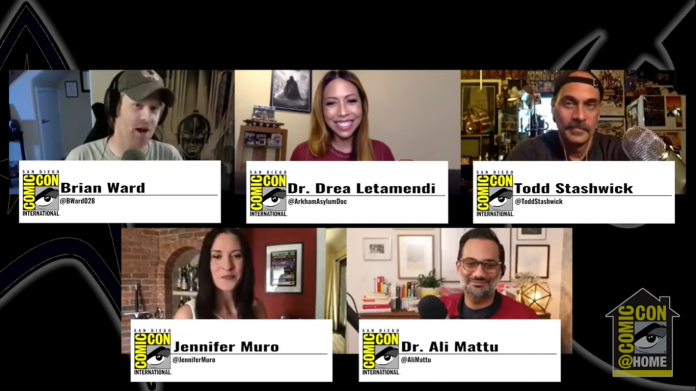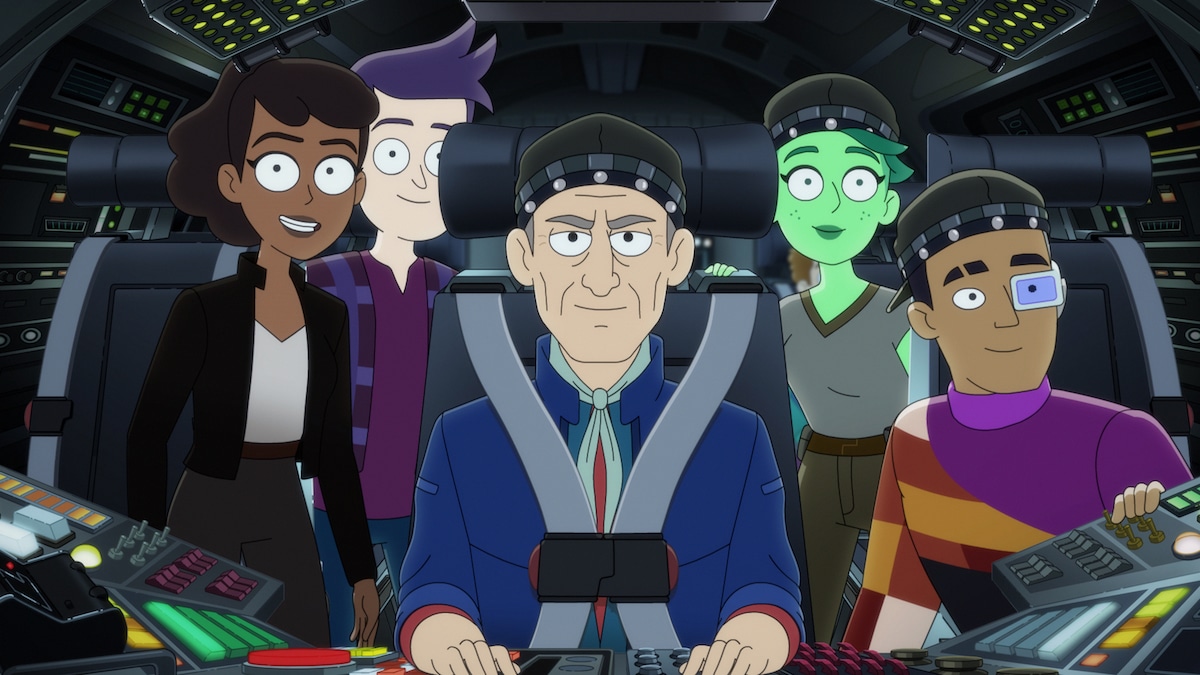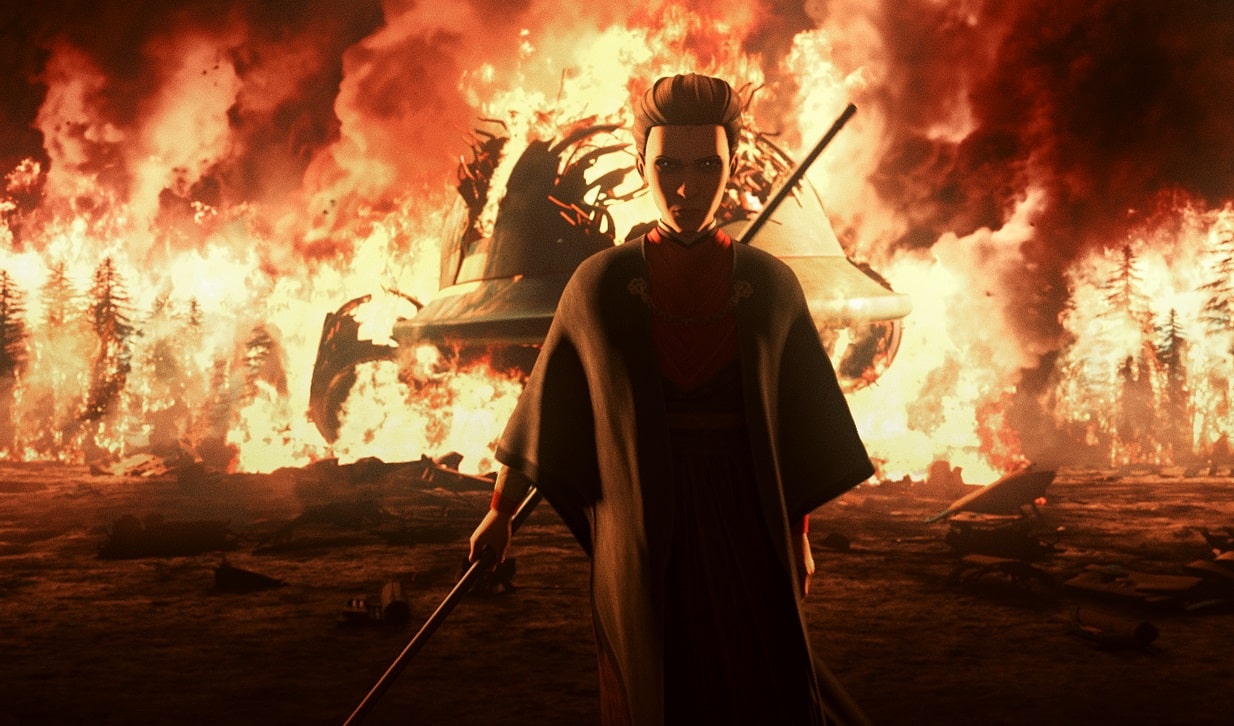Despite losing count of all the numerous space stories out there, the debate between the two biggest franchises — Star Trek and Star Wars — doesn’t seem to end. The years-long rivalry between the two is not just about the fanfare anymore — it has evolved into a friendly discourse on podcasts and online videos. Brian Ward, podcaster at The Arkham Sessions, brought two clinical psychologists and two writers together to battle it out for the winning title at SDCC 2020.
Team Star Trek: Dr. Ali Mattu (The Psych Show) and Jennifer Muro (Star Wars: Forces of Destiny)
Team Star Wars: Dr. Drea Letamendi (Lattes with Leia) and Todd Stashwick (Star Trek: Enterprise)
Q: Both groups have largely been defined by their sense of cultural identity, creed and code. How do they demonstrate real world group dynamics, and which group actually shows more promise in terms of social justice that we would like to see today? Whose principles seem more realistic?
Dr. Letamendi: “Mandalorians have a culture that has been identified as proudly carrying a similar creed, a strong code which is probably not unlike Klingons. They are really embedded in virtues around strength, bravery and combat. They [also] welcome multiple species into their culture, and that alone makes me feel like they might have an advanced level of understanding of what an ethnic group might be. We’re bound together by our strong beliefs, shared experiences and the things we truly aspire to be, and yes, if you act differently than the code, then maybe there are going to be some consequences, but for the most part there’s this connected-ness around that.”
Letamendi also cited Mandalorians’ dual emphasis on both individualism and what she called ‘belonging-ness.’ Regarding the former: “It’s the belief that we all should honor everyone’s unique characteristics and be self-reliant individually which is very apparent with the Mandalorians. But it’s not just about the individual, it’s also about community. Belonging-ness is also important,” she said, as part of a community “that matters.”
In contrast, Latamendi cited Trek‘s portrayal of Klingons as something that she’s always found problematic. “Trek has always cared about bringing up issues around oppression, racism and discrimination. With Klingon, I struggle with that there is an identified race that’s characterized by aggression, combat and violence. They seem to imply that this is an inherent part of the race.”
Dr. Mattu: “[Mandalorians] are not a race, they are not a species— I really love that idea. At the same time, I think the Klingons are a better parallel to the world we are living in right now. They are not driven by aggression and war, but they do have a very strict honor code. [Star Trek: Discovery] has different tribes of Klingons that have evolved on different planets.”
In a counter argument about Letamendi’s praise for individualism and belonging-ness in Star Wars, Mattu highlighted Worf’s character development over the years. “If you follow Worf’s journey from The Next Generation to Deep Space Nine, you see that he’s a great parallel for how we experience culture,” he said. “He’s very much integrated with his Klingon identity. He speaks Klingon very well, loves Klingon food, and also loves listening to some Klingon opera.” He also mentioned how estranged Worf is from his Klingon heritage at the same time. Mattu is referring to Worf’s lineage, adoptive parents, and his struggle to find middle ground between the two.
On Letamendi’s diversity issue with Klingons, Mattu reasoned with the fact that Star Trek: Discovery shows different tribes of Klingons that have evolved on different planets, and the divisions between them. He called this a “great parallel for some of the struggles we are experiencing about racism” and that “these tribes have been differentially empowered.”
Stashwick: “Worf is an exception, not the rule. He is the outlier to say there is hope for the future but he does not represent their culture as a whole.” Stashwick explored Worf’s history much deeper to highlight his lack of choices as a child.
“[Being a] Mandalorian is a choice. It’s not a state of birth, it’s an ideology and a creed. Therefore, it’s a point of view to choose to be a part of.” He talked about the history of Mandalorians originating from a planet which had an established social hierarchy. He compared that with the current standing of the Mandalorians that suggests they support each other during “oppressive overclass” threats. “[Mandalorians] have come to the aid of the oppressed,” he added. “When the Separatists were attacking, they flew in to assist and help the downtrodden.”
Muro: “When I think of diversity with Klingon, I think there is a slight psychological diversity in them. Worf is good even though he is the exception. He is good to see their reactions when he talks to other Klingons— some are honorable and some are really bad to him.” According to Muro, Klingons being one race is kind of how humans are in a way.
Q: We get to see [Luke Skywalker and Jean-Luc Picard] over decades as they age. How do their stories explore experiences of trauma? How do they grow emotionally? Is this relatable to our world today?
Dr. Mattu: “[Picard] is an individual who has experienced many traumas throughout his life. He was assimilated by the Borg, and lost his brother, sister-in-law and nephew in Star Trek: Generations. He has to face the Borg again in First Contact and then in Star Trek: Picard.” Throughout his many encounters with the Borg, Picard needed to “emotionally be resilient.” Mattu noted that his ship, crew and Counselor Troi helped him overcome everything and bounce back.
“When Picard got to a point where he couldn’t be resilient, being a Starfleet officer gave him such meaning and purpose.” Mattu shared a specific scene from Star Trek: Picard where Starfleet refuses to rescue the Romulans, which compromised Picard’s sense of purpose. “He did go into hiding and that is something many people do who experience trauma,” Mattu added. “His journey in Star Trek: Picard is finding meaning and purpose, and a way to negotiate all these thoughts he’s having in his head. I think it’s a beautiful story.”
Dr. Letamendi: “I actually totally agree that these two stories are about the development of emotional intelligence,” she said, defining E.Q. as our ability to understand and navigate what we are feeling, empathize and understand someone else’s experience, and let that experience allow us to behave in one way or another. “A young Luke, early on, kind of struggled,” she said. “There was a lot of intolerance and I think that’s developmentally somewhat appropriate.”
Letamendi points out how Luke comes to a point where he has conviction— he understands what it is to be a Jedi and kind of centers himself around those sets of principles. She also explained why facing real adversity actually propelled him to dig in and understand what his purpose was.
On Luke growing emotionally, she stresses his relationship with Rey on Ahch-To, where she helps him overcome guilt. “He feels responsible for Kylo Ren becoming darkened in his path. He feels that he could not have done enough to prevent that. He really just kind of lets that resentment, and feelings of self-doubt and failure permeate him. It takes Rey — it takes someone else again — to be able to understand that it’s not about [him],” she said. “He understands it’s really not about his journey, it’s about other people’s journeys. And so he needs to go out and preserve the things that are important to him. He continues to be somewhat of a pacifist.”
Muro: “But at Picard’s core, he is a diplomat. He’s always been empathetic and highly emotionally intelligent. Unfortunately, we didn’t see Picard [when he was young]. We are at the end seeing him look backwards and the choices he made to make him who he is now. And it’s the opposite with Luke. It’s an interesting switch and I just don’t know if one’s better.”
Stashwick: “When [Luke Skywalker] was young, he was being told not to let his emotions cloud his judgement. He chose to let them cloud his judgement and that actually saved his father. He then allowed emotion to overbalance his choices as he went on to become a Jedi Master. He then allowed a youthful Palpatine [Rey] to question his older self which then finally led him back to the belief of the balance, which is why he could raise that X-Wing just like Yoda, giving him full circle.”
Dr. Mattu: “You said something that just got me thinking, how lucky are we that in both franchises, we have these beloved characters we have looked up to for decades, and one of the ultimate lessons from both characters is learning from failures? Yoda reminds [Luke] to grow. And we see Troi reminding [Picard] to grow and learn from [failures]. That’s great emotionally intelligent messages for all of us to have.”
Q: Rey is from the sequel trilogy and Burnham is from Star Trek: Discovery. What do they show us about healthy coping and self care? How do they preserve or deny their heritage in order to maintain their mental well-being? What’s the importance of legacy when it comes to saving the universe?
Dr. Letamendi: “I think this is really an opportunity to show that, yes, they truly are realistic characters, and really embody some of these characteristics that you’re talking about. Ray is a character that’s essentially had to adjust and adapt to being a scavenger on a planet that she didn’t choose to live on, that this was a story of childhood abandonment and neglect. Her journey is really about developing this sense of resilience and continued hope.”
Resilience means the ability to mentally and emotionally cope with hardships, Letamendi noted. “It’s our ability to access not just our mental capacities and the assets we have but also external resources,” she explained how we utilize external resources and ask for help actually indicate resilience which in turn help us grow in various ways. “We see all the different ways [Rey] embodies resilience— she is competent, which people don’t like. But she’s a young woman who’s competent, knows different languages, can build a speeder, can forage and scavenge successfully. She’s creative, has self-confidence. She carries herself with a strong sense of integrity, despite messages that she is, you know, not important in this universe.”
“But she faces adversity, and struggles to find herself. We see self-gratifying moments despite the randomness and harshness of [Jakku]. As Kylo says very clearly, ‘You know, your weakness is that you’re no one’ before she learns who she is. That was very true. She struggles with who she is and who she belongs to. But her ability to find contentment in various moments can be very uplifting as ourselves. We’re all in some state, in some phase or chapter of our journeys, just trying to find ourselves.”
Dr. Mattu: “And this is one of those moments where Dr. Letamendi, I love everything you said. I love Rey and her journey! We see that with both of these characters. We see that with Michael Burnham. We find out that she has been raised by probably the most famous parents in Star Trek. And she is the sibling to probably the most famous character Spock, and raised by Sara and Amanda. And what I think is so wonderful about Michael Burnham’s story is she is coming from a wide variety of backgrounds. She is a black woman who lost her parents in an attack and experience some discrimination [on Vulcan].
“Anyone can be raised in Vulcan and gain some of those qualities, so that’s getting back at you for the Mandalorian stuff. So for me, Michael Burnham is really a character that celebrates how important it is to have different experiences and to have a team that has people with many perspectives. Diversity is better. It is harder. It’s harder to have a team of people where people come from different perspectives. But if you can bring all those people together, it’s a super power that will help you solve problems. “
Mattu also noted that the whole story is about reconnecting with what Starfleet is and how much they support each other. “There’s such cool research about how much reconnecting with the meaning behind what you do can help you through tough times,” he said, disappointed that this discourse could not have taken place in person at Comic-Con. But Mattu focused his time reconnecting with what he does and finding meaning within it. “Reconnecting with your purpose and meaning—that is such an essential skill that can help leave so much suffering and give us the skills to be resilient in the face of all this stuff,” he added. “That’s what Star Trek: Beyond is all about. And I’m a big fan and I will bait anyone who wants to talk negatively about the Kelvin Timeline.”
Q: Jen, let’s talk about the Kelvin Timeline versus the [Star Wars] sequel trilogy?
Muro: “I think the two things I do like about the Kelvin Timeline is: one, seeing [Kirk] in his younger self. This rowdiness was interesting, kind of seeing Pile in a different way. Also Chris Pine is awesome. But the second thing is the destruction of Vulcan, which was really hard for me,” she said. “I just felt like that psychologically matters in the Kelvin Timeline.” Muro was delighted to see these two events on screen, especially the effect of Vulcan’s end on Spock.
Stashwick: “To talk about the Kelvin Timeline and Star Wars, to talk about [J.J. Abrams]’s Star Wars and Star Trek, you are talking about the same movie because— the Star Trek, the one he rebooted— he just beat-by-beat kind of did A New Hope,” he drew parallel between both the movies where there’s destruction of a planet using a large machine, there’s a farm boy looking for a bright future and much more. “J.J. clearly was a Star Wars fan, handed the keys to the Star Trek kingdom, and made a Star Wars version of Star Trek,” he added.
For Stashwick, Star Wars has a beautiful mental health message for its viewers. He said blowing up a Death Star once will not end all problems forever, and that it is an internal struggle with a noble pursuit. He also compared battles fought in the Star Wars realm to longer systemic battles in the real world that people have to face and pass on to the younger generation so they can be “fortified to fight these battles when we are no longer able to as old people.” He called this philosophy the “beauty of the sequel trilogy” and said the “struggle is real and will find its way back.
At the end of the discourse, there was no clear winner, which wasn’t surprising. Both the universes are gradually expanding and it’s great to hear psychological experts break down hidden meanings filmmakers leave for fans that usually go unnoticed at the first viewing.
Miss any of our other SDCC 2020 coverage? Click here for much more!










Hasn’t this debate been going on since at least 1977?
Comments are closed.